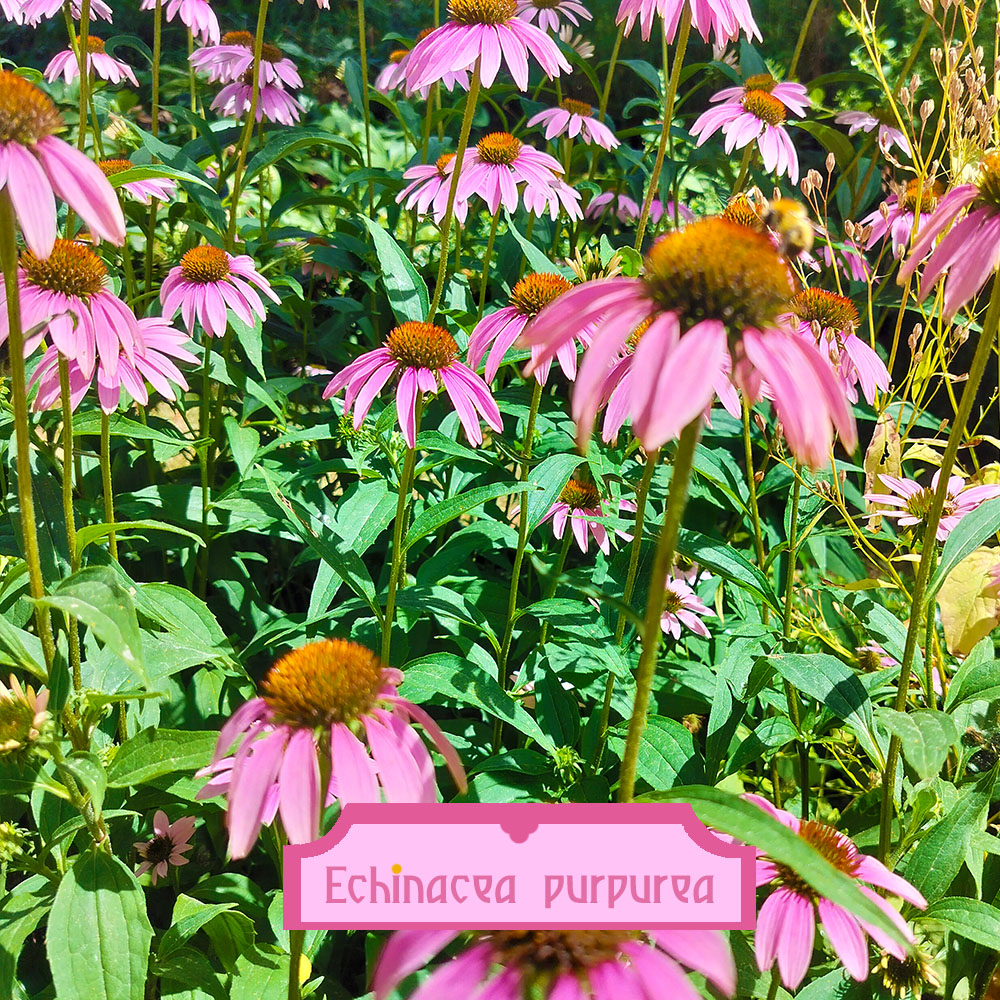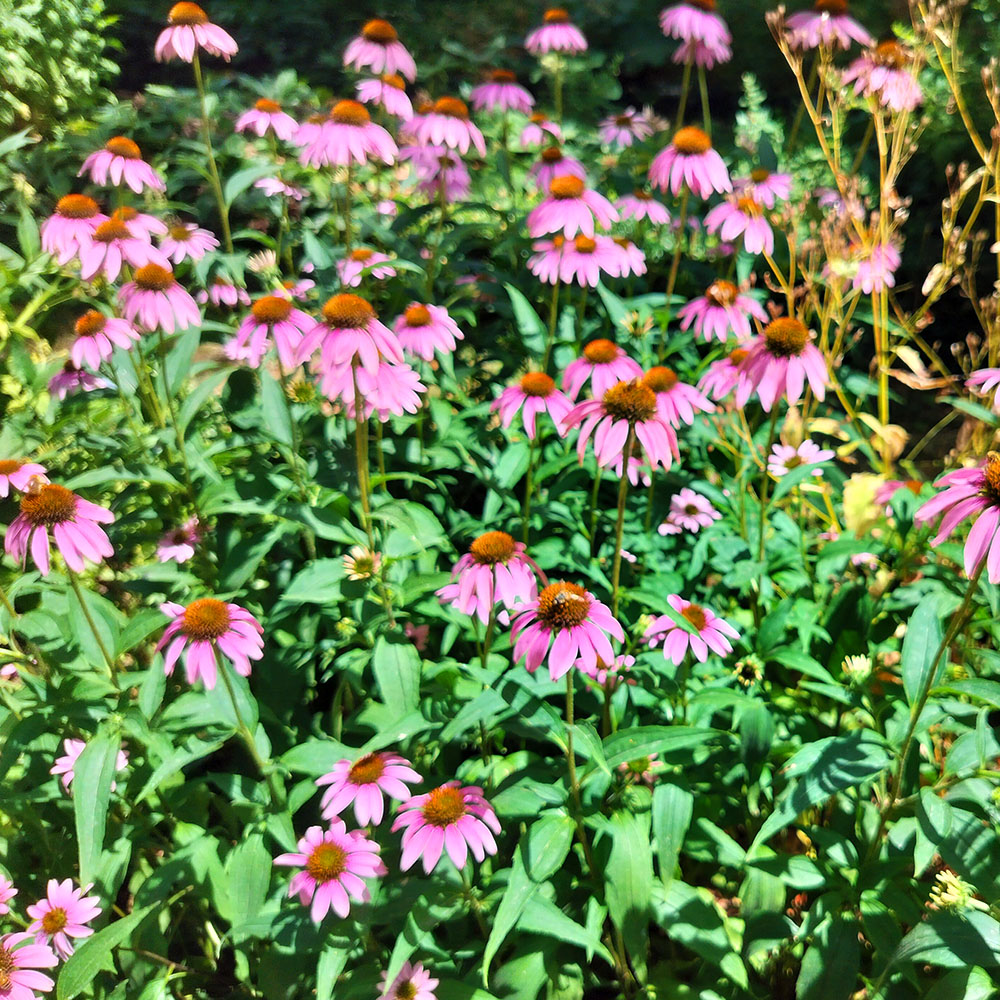No products in the cart.
Echinacea purpurea
Une vivace aux fleurs violettes tout au long de l'été.
Note 0 sur 5
0 avis clients
4,90 €
Seulement 13 en stock!
Tags: fleurs, longue floraison, vivace, persistant, plant, secheresse, soleil, vivace
SKU: pda137
Catégorie: Pour les Abeilles et les Papillons, Bouquet, Distillations, Résistantes au Gel, Couvre-Sol, Couleurs Eclatantes, Médicinales, Réensauvagement, Les Eblouissantes

Echinacea purpurea
4,90 €
Seulement 13 en stock!
Echinacea purpurea is a hardy, fast-growing perennial native to North America, widely cultivated for its ornamental, ecological, and medicinal value.
The flowers are cone-shaped and usually, but not always, purple in the wild. The blooms are long lasting – sometimes up to five months!
Toutes sortes d'abeilles sont attirées par ces fleurs, y compris les bourdons, les abeilles sudoripares, les abeilles domestiques, l'abeille coupeuse de feuilles de tournesol et l'abeille mineuse. Andrena helianthiformis.
Et les papillons ! Les papillons notables comprennent les monarques, les papillons machaons et les papillons soufrés.
Et les oiseaux ! La plante produit des akènes (un fruit sec) qui sont recherchés par les oiseaux, en particulier les pinsons.
CONSEILS DE JARDINAGE: Echinacea purpurea
-
- SOIL: Prefers well-drained conditions and full sun, though it tolerates partial shade.
- DROUGHT TOLERANCE: Once established, Echinacea is drought-tolerant and resilient, capable of surviving in relatively poor soils where many perennials struggle.
- S’accorde parfaitement avec Echinops ritro, Achillea Boule de Neige, Nepeta x faassenii
Learn more about gardening with Echinacea:
Les Contes et La Botanique : Echinacea purpurea
Echinacea signifie « épineux » en grec, en référence aux oursins épineux "εχίνοι" dont les têtes de fleurs mûres de ce genre ressemblent.
Extracts of the plant have shown to have immunostimulant properties and were cultivated commercially in Germany around 1939 and in Switzerland around 1950.
Bien qu'il existe plus de 400 publications concernant la plante et des dizaines de préparations d'échinacée sur le marché, la véritable identité de nombreux principes actifs reste encore inconnue.
Aujourd'hui, les gens utilisent l'échinacée pour raccourcir la durée du rhume et de la grippe, et réduire les symptômes tels que le mal de gorge (pharyngite), la toux et la fièvre.
It is one of the most widely studied medicinal plants, with over 400 scientific publications addressing its pharmacological potential.
Despite decades of study, the exact identity and mechanisms of all active compounds remain partially unresolved, making it a continuing subject of botanical and pharmacological research.
Ecology and Pollinators
Echinacea purpurea is an ecological powerhouse.
Its flowers attract a wide range of pollinators, including bumblebees, sweat bees, honeybees, the sunflower leafcutter bee, and the mining bee Andrena helianthiformis.
Butterflies are frequent visitors, with notable species including monarchs, swallowtails, and sulphur butterflies.
The dense flower heads provide a concentrated source of nectar and pollen, supporting pollinator populations over the long flowering season.
Birds are also drawn to Echinacea, particularly finches, which feed on the seeds (achenes) produced in late summer and autumn.
The spiny central cone protects the seeds until they are fully mature, allowing birds to feed gradually.
This dual role—providing nectar for pollinators and seeds for birds—makes Echinacea an important plant for supporting biodiversity in garden and wild landscapes alike.
Autres Noms
Eastern purple coneflower
Purple coneflower
Hedgehog coneflower
Origine
Amérique du Nord
| Poids | 0,5 kg |
|---|---|
| Floraison | Juillet, Août, Septembre, Octobre |
| Sol | Frais, Sableux |
| Exposition | ☀️ Plein soleil |
| Rusticité | -20°C to -25°C |
| Taille | 0.8m H x 0.4m L |
Commentaires
0
Note 0 sur 5
0 avis clients
5
0
4
0
3
0
2
0
1
0
Seuls les utilisateurs connectés les clients qui ont acheté ce produit peuvent laisser un avis.
Autres Produits
Cerastium tomentosum var. columnae
Un couvre-sol étalé gris-vert des montagnes.
Un couvre-sol étalé gris-vert des montagnes.
Note 0 sur 5
Trachelospermum asiaticum ‘Ogon Nishiki’
Jasmine with colorful foliage and lovely white flowers in summer
Jasmine with colorful foliage and lovely white flowers in summer
Note 0 sur 5
Artemisia Valerie Finnis
Une variation de l'Artemisia semi-persistante et aromatique
Une variation de l'Artemisia semi-persistante et aromatique
Note 0 sur 5
Euphorbia cyparissias Clarice Howard
Une Euphorbia qui ressemble à un doux petit cyprès
Une Euphorbia qui ressemble à un doux petit cyprès
Note 0 sur 5
Potentilla anserina
Une vivace argentée, soyeuse et dentelée.
Une vivace argentée, soyeuse et dentelée.
Note 0 sur 5
Glechoma hederacea
Un couvre-sol au parfum doux, produisant de petites fleurs bleues tout au long de l'été.
Un couvre-sol au parfum doux, produisant de petites fleurs bleues tout au long de l'été.
Note 0 sur 5
Hellebore argutifolius
Plante vivace à fleurs d'hiver avec des feuilles bleu-vert marbrées.
Plante vivace à fleurs d'hiver avec des feuilles bleu-vert marbrées.
Note 0 sur 5
Stachys byzantina
Feuilles soyeuses blanc-gris et grandes fleurs saisissantes.
Feuilles soyeuses blanc-gris et grandes fleurs saisissantes.
Note 0 sur 5
Mentha x piperita ‘Chartreuse’
Un menthe épicée, connue pour son utilisation dans la production de liqueurs et de tisanes.
Un menthe épicée, connue pour son utilisation dans la production de liqueurs et de tisanes.
Note 0 sur 5
Euphorbia myrsinites
Connue pour sa forme retombante de feuillage gris argenté et ses fleurs éclatantes.
Connue pour sa forme retombante de feuillage gris argenté et ses fleurs éclatantes.
Note 0 sur 5
Tanacetum densum subsp amani
Un petit arbuste composé de feuilles douces et finement divisées de couleur gris argenté-blanc.
Un petit arbuste composé de feuilles douces et finement divisées de couleur gris argenté-blanc.
Note 0 sur 5
Tradescantia Blushing Bride
Magnifiques touches de rose et de blanc qui apparaissent lors des nuits les plus froides
Magnifiques touches de rose et de blanc qui apparaissent lors des nuits les plus froides
Note 0 sur 5
Melissa officinalis
Une aromatique adorée par les abeilles, les familles royales et les amateurs de thé.
Une aromatique adorée par les abeilles, les familles royales et les amateurs de thé.
Note 0 sur 5
Erigeron kavinskianus
Un tapis de fleurs en forme de marguerites.
Un tapis de fleurs en forme de marguerites.
Note 0 sur 5
Delosperma cooperi
Une vivace naine connue pour ses fleurs de couleur vermillon.
Une vivace naine connue pour ses fleurs de couleur vermillon.
Note 0 sur 5
Vinca minor
Looping elegance and ability to form a low flowering ground cover
Looping elegance and ability to form a low flowering ground cover
Note 0 sur 5
Kalanchoe daigremontiana
Une succulente dentelée originaire de Madagascar, connue sous le nom de Mère de Mille.
Une succulente dentelée originaire de Madagascar, connue sous le nom de Mère de Mille.
Note 0 sur 5
Vu récemment
Geranium sanguineum ‘Hannelore’
Un géranium résistant plus court avec des fleurs rose vif et des veines pourpres foncées.
Un géranium résistant plus court avec des fleurs rose vif et des veines pourpres foncées.
Note 0 sur 5
Centranthus ruber
Une vivace merveilleusement résistante, produisant des fleurs rouges éclatantes.
Une vivace merveilleusement résistante, produisant des fleurs rouges éclatantes.
Note 0 sur 5
Persicaria microcephala ‘Red Dragon’
Un feuillage violet profond, des tiges rouges vives et des fleurs blanches
Un feuillage violet profond, des tiges rouges vives et des fleurs blanches
Note 0 sur 5
Salvia officinalis subsp. lavandulifolia
Salvia officinalis subsp. *lavandulifolia* est une petite plante vivace ligneuse avec des feuilles lancéolées vert-blanc qui dégagent un parfum de romarin et de lavande.
Salvia officinalis subsp. *lavandulifolia* est une petite plante vivace ligneuse avec des feuilles lancéolées vert-blanc qui dégagent un parfum de romarin et de lavande.
Note 0 sur 5
Tinantia pringlei ‘Variegata’
A variegated Commelinaceae with cream-white stripes and dark sprinkles on top.
A variegated Commelinaceae with cream-white stripes and dark sprinkles on top.
Note 0 sur 5
















































Il n'y a pas encore de reviews.